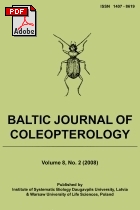Community assemblage of the Carabidae fauna in newly created habitats
Main Article Content
Keywords
:
Assembly rules; Dispersal ability; Isolation; Low productivity community; Restoration; Species conservation; Topsoil removal.
Abstract
Removal of topsoil on former agricultural fields resulted in a rapid reduction in soil fertility. Insight into the general principles determining invertebrate faunal community assemblage after removal of topsoil was studied by correlating assemblage of the carabid community ten years after topsoil removal, to traits related to abiotic preferences, dispersal ability and the relative abundance of species. Special emphasis is put on the animal species characteristic of low production communities (target species). Results showed that newly exposed sites were rapidly colonized by Carabidae. Both abiotic preference and dispersal ability to some extent influenced community assemblage. Over time the importance of abiotic conditions on community assemblage increased, whilst dispersal restrictions seemed to decrease. During the first ten years chance factors appeared to be of major importance on community assemblage.<br />Isolated restoration sites were almost exclusively colonised by flying species. Restoration of the characteristic invertebrate carabid fauna of low production communities thus requires the presence of source populations in the immediate surroundings. It is concluded that restoration of low production communities on former agricultural land is an effective conservation method for carabid beetles, particularly for endangered, non-flying, large species.
Article Details
Statistics
Downloads
Download data is not yet available.
Recommend Articles
